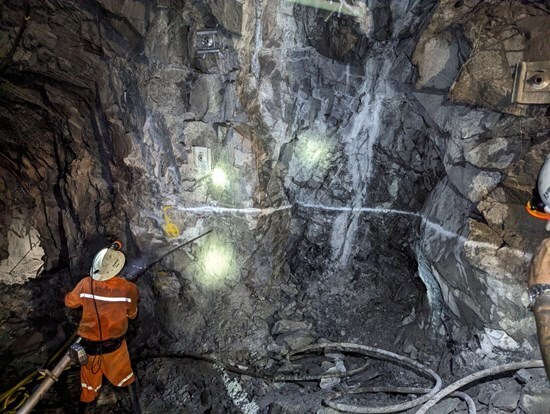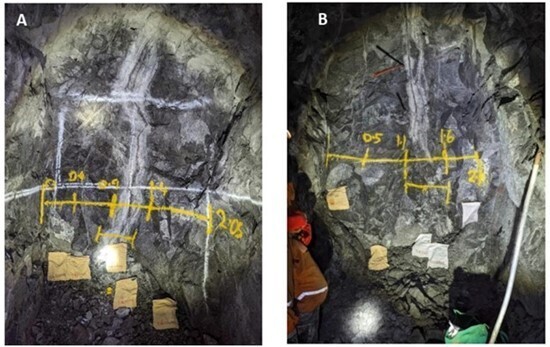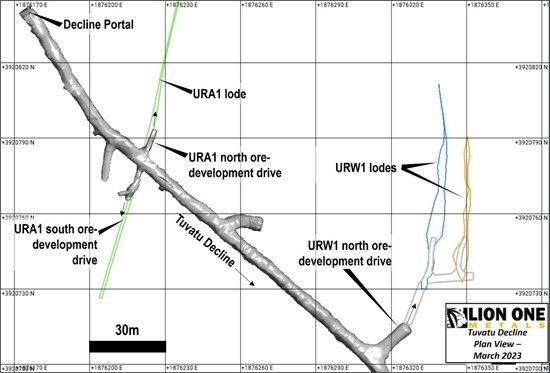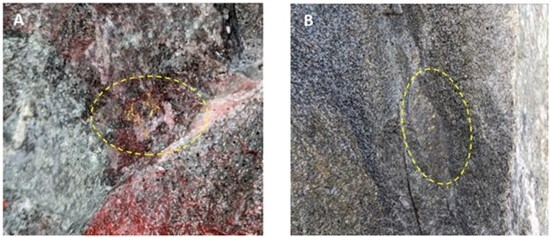North Vancouver, British Columbia--(Newsfile Corp. - April 3, 2023) - Lion One Metals Limited (TSXV: LIO) (OTCQX: LOMLF) (ASX: LLO) ("Lion One" or the "Company") announces a significant milestone at Tuvatu. Initial mining of near-surface, high-grade gold bearing mineralization has commenced from a recently discovered mineralized lode. To date, strike driving along the new lode totals 14 cuts for an estimated 475 tonnes, much of which has already been added to the Company's mining inventory stockpile. The high-grade inventory stockpile will constitute the initial feed for the Company's custom-designed-for-purpose processing facility, currently under construction.

Figure 1. Photo of the first cut on the lode, strike drive from the new development decline.
To view an enhanced version of this graphic, please visit:
https://images.newsfilecorp.com/files/2178/160996_b31709b2f410681d_001full.jpg
New Gold Lode
The new lode was discovered in late 2022, 75 meters into the new development decline, and was subsequently defined by underground mapping, chip-channel sampling, and diamond drilling.
Development along the strike has since been extended by 13m, by way of 7 separate cuts, each cut representing approximately 30 tonnes of material. Vertical development of 9m as a 1.5 x 1.5m rise has been completed, as well as an additional 7 cuts, for a total of approximately 475 tonnes of gold mineralized material, to date. Tuvatu has implemented airleg mining, which allows for flexibility and optionality to deliver low-cost tonnage at minimum mining widths of 1.8m and a rate of advancement of 4m/day.
Several recent drillholes have intersected multiple high grade intercepts. Systematic face sampling provides detailed information that compare favourably with previous drill results.
The material extracted from this drive represents the first modern extraction from the Tuvatu deposit, and as such represents a significant milestone for the company.
Table 1. Composited results from drillholes intersecting the lode. Coordinates are in Fiji map grid.
| Hole ID | From (m) | To (m) | Interval (m) | Au g/t | Easting | Northing | Elevation | Azimuth | Dip |
| TUDDH-617 | 56.1 | 58.2 | 2.1 | 1.76 | 1876512.6 | 3920929.1 | 236.3 | 097 | -60 |
| including | 57.9 | 58.2 | 0.3 | 6.30 | |||||
| 59.7 | 63.3 | 3.6 | 2.93 | ||||||
| including | 59.7 | 60.0 | 0.3 | 17.01 | |||||
| TUDDH-619 | 65.0 | 65.3 | 0.3 | 3.48 | 1876257.7 | 3920801.2 | 203.2 | 266 | -60 |
| TUDDH-621 | 159.3 | 160.5 | 1.2 | 27.99 | 1876257.7 | 3920799.9 | 203.0 | 297 | -60 |
| TUDDH-624 | 79.1 | 81.2 | 2.1 | 20.16 | 1876257.5 | 3920800.1 | 203.1 | 262 | -65 |
| including | 79.1 | 80.3 | 1.2 | 33.04 | |||||
| including | 79.7 | 80.0 | 0.3 | 106.99 | |||||
| TUDDH-542 | 79.8 | 81.5 | 1.7 | 1.65 | 1876170.4 | 3920845.3 | 166.6 | 139 | -7 |
| including | 79.8 | 80.1 | 0.3 | 5.77 | |||||
| TUDDH-359 | 93.24 | 95.68 | 2.44 | 4.21 | 1876222.0 | 3920742.0 | 207.6 | 359 | -65 |
| including | 93.24 | 93.65 | 0.41 | 10.85 | |||||
| TUDDH-355 | 31.63 | 32.0 | 0.37 | 8.96 | 1876223.0 | 3920779.0 | 203.5 | 359 | -63 |
| TUDDH-086 | 241.25 | 243.3 | 2.05 | 9.14 | 1876335.0 | 3920736.0 | 226.5 | 279 | -60 |
| including | 241.25 | 241.95 | 0.7 | 18.7 |
Table 2. Selected chip-channel results from sampling in the development decline, face samples along successive cuts of the strike drive along lode, and samples from the rise lode. Coordinates are in Fiji map grid.
| Channel ID | From | To | Interval | Au | Coordinates | Elevation | Final depth | Azimuth | Dip | |
| m | m | m | g/t | Easting | Northing | m | m | deg. | deg. | |
| MD-CH-001 | 0.0 | 2.5 | 2.5 | 9.94 | 1876219.1 | 3920779.2 | 157.6 | 2.5 | -13 | -13 |
| 1.0 | 1.5 | 0.5 | 32.57 | |||||||
| MD-CH-002 | 0.0 | 1.0 | 1.0 | 29.02 | 1876219.2 | 3920779.0 | 158.6 | 1.5 | -13 | -13 |
| 0.5 | 1.0 | 0.5 | 55.12 | |||||||
| MD-CH-003 | 1.0 | 3.0 | 2.0 | 8.91 | 1876227.3 | 3920778.8 | 156.0 | 3 | -13 | -13 |
| 2.5 | 3.0 | 0.5 | 22.48 | |||||||
| MD-CH-004 | 1.5 | 3.0 | 1.5 | 11.93 | 1876228.0 | 3920778.1 | 155.5 | 3 | -14 | -14 |
| 1.5 | 2.0 | 0.5 | 26.09 | |||||||
| MD-CH-005 | 1.0 | 2.5 | 1.5 | 15.17 | 1876220.6 | 3920784.2 | 157.5 | 4 | -14 | -14 |
| 1.5 | 2.0 | 0.5 | 41.94 | |||||||
| MD-CH-006 | 1.5 | 3.0 | 1.5 | 10.88 | 1876220.4 | 3920784.9 | 158.7 | 4 | -11 | -11 |
| 1.5 | 2.0 | 0.5 | 31.17 | |||||||
| MD-CH-011 | 0.0 | 2.5 | 2.5 | 10.46 | 1876232.2 | 3920768.5 | 155.3 | 2.5 | -13 | -13 |
| 1.5 | 2.0 | 0.5 | 44.30 | |||||||
| 1155URA1STHOD.02 | 0.0 | 1.4 | 1.4 | 14.70 | 1876220.2 | 3920774.4 | 157.0 | 2.05 | 0 | 0 |
| 0.9 | 1.4 | 0.5 | 29.20 | |||||||
| 1155URA1STHOD.03 | 0.0 | 2.4 | 2.4 | 7.57 | 1876219.8 | 3920772.6 | 156.9 | 2.4 | 0 | 0 |
| 1.0 | 1.45 | 0.45 | 32.89 | |||||||
| 1155URA1STHOD.04 | 0.7 | 1.6 | 0.9 | 15.86 | 1876219.5 | 3920771.0 | 157.2 | 2 | 0 | 0 |
| 1.3 | 1.6 | 0.3 | 39.60 | |||||||
| 1155URA1STHOD.05 | 0.6 | 1.3 | 0.7 | 3.23 | 1876218.8 | 3920769.5 | 157.2 | 2.6 | 0 | 0 |
| 1155URA1STHOD.06 | 0.0 | 2.2 | 2.2 | 3.69 | 1876217.6 | 3920768.0 | 157.4 | 3 | 0 | 0 |
| 1155URA1STHOD.07 | 0.0 | 2.7 | 2.7 | 6.89 | 1876216.5 | 3920766.4 | 157.9 | 2.7 | 0 | 0 |
| 0.5 | 1.0 | 0.5 | 24.88 | |||||||
| 1155URA1NTHOD.05 | 0.0 | 1.6 | 1.6 | 2.18 | 1876223.9 | 3920790.8 | 158.0 | 2 | 0 | 0 |
| 1.2 | 1.6 | 0.4 | 8.07 | |||||||
| 1155URA1NTHOD.08 | 0.5 | 2.0 | 1.5 | 3.95 | 1876226.4 | 3920796.8 | 157.4 | 2.1 | 0 | 0 |
| 1.2 | 1.6 | 0.4 | 14.42 | |||||||
| Rise STH side | 1.2 | 2.0 | 10.35 | 1876214.8 | 3920767.3 | 159.9 | 7 | 60.7 | 60.7 | |
| 3.0 | 4.0 | 9.48 | ||||||||
| 4.0 | 5.0 | 20.19 | ||||||||
| Rise NTH side | 0.0 | 1.2 | 12.84 | 1876215.4 | 3920769.8 | 159.8 | 7 | 54.6 | 54.6 | |
| 3.0 | 4.0 | 12.85 | ||||||||
| 5.0 | 6.0 | 13.93 | ||||||||

Figure 2 A. Photo of lode cut No. 2 face of the South strike drive from the development decline;
Figure 2 B. Photo of lode cut No. 7 face of the North strike drive.
To view an enhanced version of this graphic, please visit:
https://images.newsfilecorp.com/files/2178/160996_figure2.jpg
Further Near-Term Development
Figure 3 shows a rendering of the development along the new lode to date. Figure 3 also provides an update to the total development achieved to date along the main decline, toward the important additional lode on which much of the detailed grade control drilling has been focused. It is expected that the decline will reach this additional high-grade lode, likely within the next month.

Figure 3. Plan view rendering of the current as-built model of the underground development completed to date. The entrance to the decline is at the top left. The location of the new lode (green) and additional lodes (blue and orange) are shown. The open gray shape indicates planned development to expose the lodes. North is toward the top of the image. Coordinates are in Fiji map grid.
To view an enhanced version of this graphic, please visit:
https://images.newsfilecorp.com/files/2178/160996_b31709b2f410681d_006full.jpg
Geology
The well-defined structure consists of a quartz vein array with minor to trace pyrite, chalcopyrite, sphalerite and bornite, as well as coarse native gold (Figures 4a, b), typically in association with roscoelite. Late carbonate veinlets crosscut the structure. The vein is hosted by monzonite, with well developed symmetric bleached alteration. The highly visible alteration envelope has rendered advancement on this mineralized structure very straight-forward by way of visual identification alone.

Figure 4. Photos of coarse visible gold in samples collected from the lode. A) 158.7m elevation, width of photo is ~25cm across; B) 159.5m elevation, width of photo is ~30cm across.
To view an enhanced version of this graphic, please visit:
https://images.newsfilecorp.com/files/2178/160996_figure4.jpg
About Tuvatu
The Tuvatu Alkaline Gold Project is located on the island of Viti Levu in Fiji. The January 2018 mineral resource for Tuvatu as disclosed in the technical report "Technical Report and Preliminary Economic Assessment for the Tuvatu Gold Project, Republic of Fiji", dated September 25, 2020, and prepared by Mining Associates Pty Ltd of Brisbane Qld, comprises 1,007,000 tonnes indicated at 8.50 g/t Au (274,600 oz. Au) and 1,325,000 tonnes inferred at 9.0 g/t Au (384,000 oz. Au) at a cut-off grade of 3.0 g/t Au. The technical report is available on the Lion One website at www.liononemetals.com and on the SEDAR website at www.sedar.com.
Qualified Person
In accordance with National Instrument 43-101 - Standards of Disclosure for Mineral Projects ("NI 43- 101"), Sergio Cattalani, P.Geo, Senior Vice President Exploration, is the Qualified Person for the Company and has reviewed and is responsible for the technical and scientific content of this news release.
QAQC Procedures
Lion One adheres to rigorous QAQC procedures above and beyond basic regulatory guidelines in conducting its sampling, drilling, testing, and analyses. The Company utilizes its own fleet of diamond drill rigs, using PQ, HQ and NQ sized drill core rods. Drill core is logged and split by Lion One personnel on site. Samples are delivered to and analyzed at the Company's geochemical and metallurgical laboratory in Fiji. Duplicates of all samples with grades above 0.5 g/t Au are both re-assayed at Lion One's lab and delivered to ALS Global Laboratories in Australia (ALS) for check assay determinations. All samples for all high-grade intercepts are sent to ALS for check assays. All samples are pulverized to 85% passing through 75 microns. Gold analysis is carried out using fire assay with an AA finish. Samples that have returned grades greater than 10.00 g/t Au are then re-analyzed by gravimetric method. For samples that return greater than 0.50 g/t Au, repeat fire assay runs are carried out and repeated until a result is obtained that is within 10% of the original fire assay run. Lion One's laboratory can also assay for a range of 71 other elements through Inductively Coupled Plasma Optical Emission Spectrometry (ICP-OES), but currently focuses on a suite of 9 important pathfinder elements. All duplicate anomalous samples are sent to ALS labs in Townsville QLD and are analyzed by the same methods (Au-AA26, and Au-GRA22 where applicable). ALS also analyses 33 pathfinder elements by HF-HNO3-HClO4 acid digestion, HCl leach and ICP-AES (method ME-ICP61).
About Lion One Metals Limited
Lion One's flagship asset is 100% owned, fully permitted high grade Tuvatu Alkaline Gold Project, located on the island of Viti Levu in Fiji. Lion One envisions a low-cost high-grade underground gold mining operation at Tuvatu coupled with exciting exploration upside inside its tenements covering the entire Navilawa Caldera, an underexplored yet highly prospective 7km diameter alkaline gold system. Lion One's CEO Walter Berukoff leads an experienced team of explorers and mine builders and has owned or operated over 20 mines in 7 countries. As the founder and former CEO of Miramar Mines, Northern Orion, and La Mancha Resources, Walter is credited with building over $3 billion of value for shareholders.
On behalf of the Board of Directors of
Lion One Metals Limited
"Walter Berukoff", Chairman and CEO
Contact Investor Relations
Toll Free (North America) Tel: 1-855-805-1250
Email: [email protected]
Website: www.liononemetals.com
Neither the TSX Venture Exchange nor its Regulation Service Provider accepts responsibility for the adequacy or accuracy of this release
This press release may contain statements that may be deemed to be "forward-looking statements" within the meaning of applicable Canadian securities legislation. All statements, other than statements of historical fact, included herein are forward-looking information. Generally, forward-looking information may be identified by the use of forward-looking terminology such as "plans", "expects" or "does not expect", "proposed", "is expected", "budget", "scheduled", "estimates", "forecasts", "intends", "anticipates" or "does not anticipate", or "believes", or variations of such words and phrases, or by the use of words or phrases which state that certain actions, events or results may, could, would, or might occur or be achieved. This forward-looking information reflects Lion One Metals Limited's current beliefs and is based on information currently available to Lion One Metals Limited and on assumptions Lion One Metals Limited believes are reasonable. These assumptions include, but are not limited to, the actual results of exploration projects being equivalent to or better than estimated results in technical reports, assessment reports, and other geological reports or prior exploration results. Forward-looking information is subject to known and unknown risks, uncertainties and other factors that may cause the actual results, level of activity, performance or achievements of Lion One Metals Limited or its subsidiaries to be materially different from those expressed or implied by such forward-looking information. Such risks and other factors may include, but are not limited to: the stage development of Lion One Metals Limited, general business, economic, competitive, political and social uncertainties; the actual results of current research and development or operational activities; competition; uncertainty as to patent applications and intellectual property rights; product liability and lack of insurance; delay or failure to receive board or regulatory approvals; changes in legislation, including environmental legislation, affecting mining, timing and availability of external financing on acceptable terms; not realizing on the potential benefits of technology; conclusions of economic evaluations; and lack of qualified, skilled labour or loss of key individuals. Although Lion One Metals Limited has attempted to identify important factors that could cause actual results to differ materially from those contained in forward-looking information, there may be other factors that cause results not to be as anticipated, estimated or intended. Accordingly, readers should not place undue reliance on forward-looking information. Lion One Metals Limited does not undertake to update any forward-looking information, except in accordance with applicable securities laws.

To view the source version of this press release, please visit https://www.newsfilecorp.com/release/160996
Original Source of the original story >> Lion One Commences High Grade Gold Mining at Tuvatu






